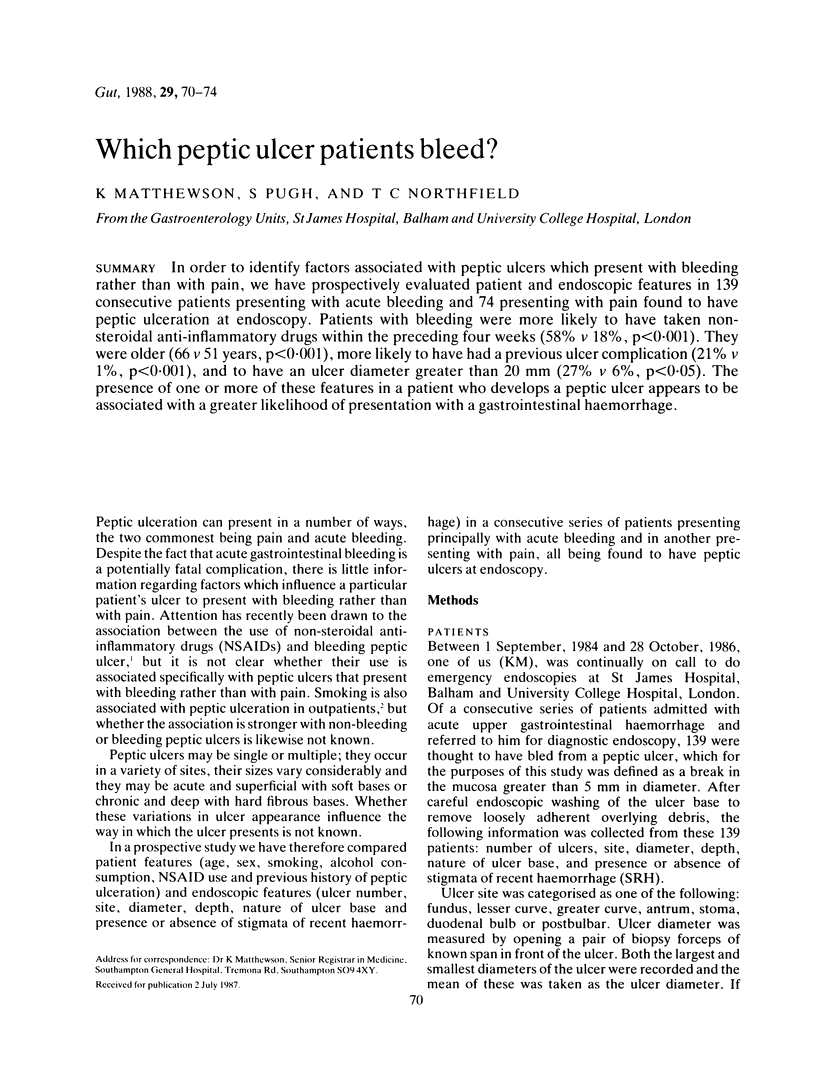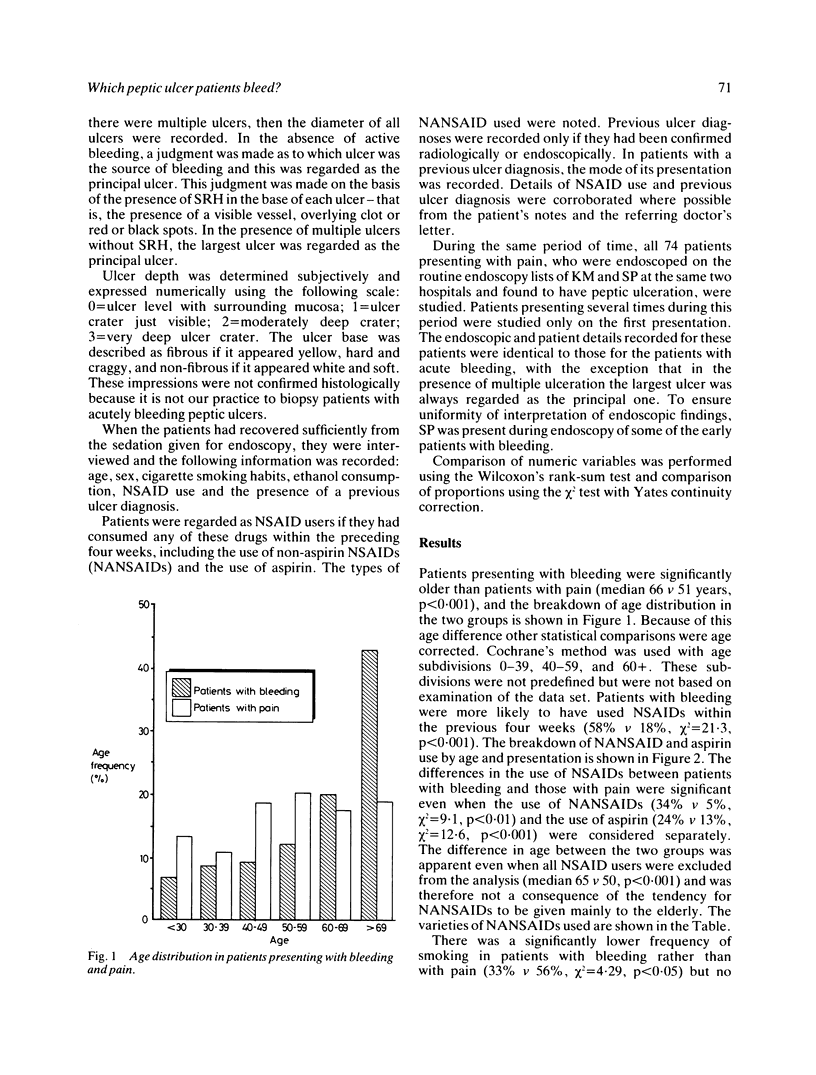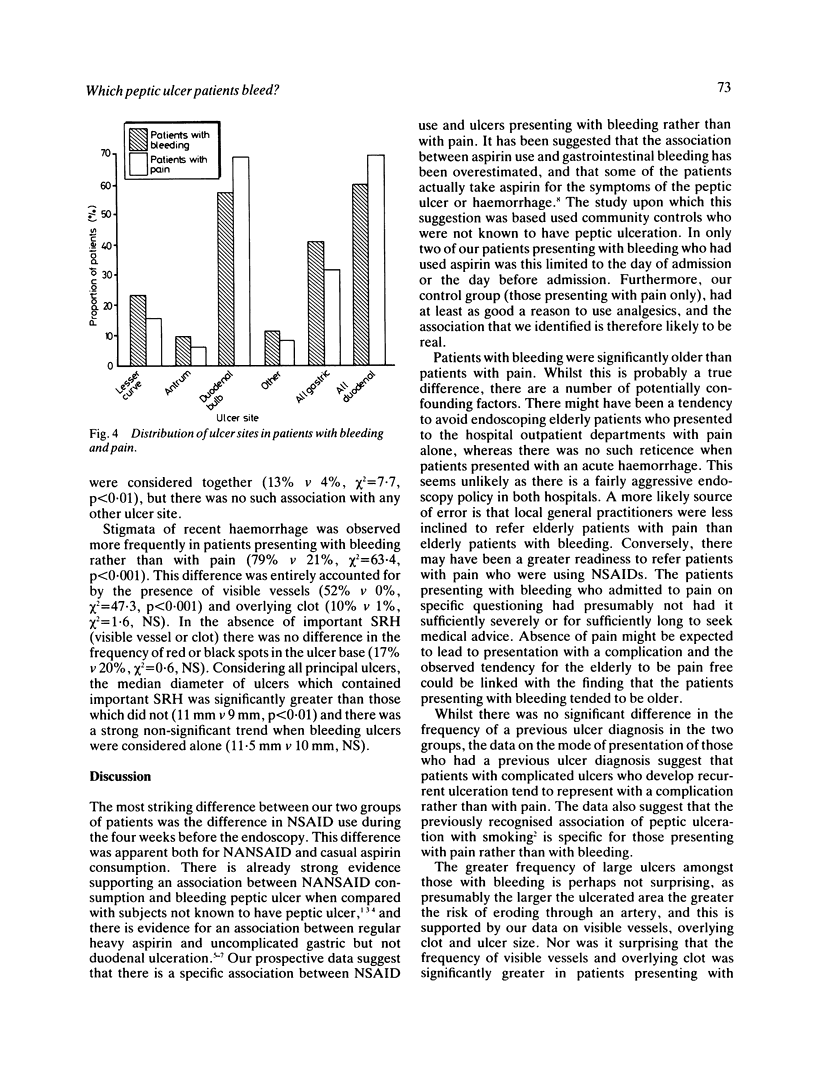Abstract
In order to identify factors associated with peptic ulcers which present with bleeding rather than with pain, we have prospectively evaluated patient and endoscopic features in 139 consecutive patients presenting with acute bleeding and 74 presenting with pain found to have peptic ulceration at endoscopy. Patients with bleeding were more likely to have taken non-steroidal anti-inflammatory drugs within the preceding four weeks (58% v 18%, p less than 0.001). They were older (66 v 51 years, p less than 0.001), more likely to have had a previous ulcer complication (21% v 1%, p less than 0.001), and to have an ulcer diameter greater than 20 mm (27% v 6%, p less than 0.05). The presence of one or more of these features in a patient who develops a peptic ulcer appears to be associated with a greater likelihood of presentation with a gastrointestinal haemorrhage.
Full text
PDF




Selected References
These references are in PubMed. This may not be the complete list of references from this article.
- Ainley C. C., Forgacs I. C., Keeling P. W., Thompson R. P. Outpatient endoscopic survey of smoking and peptic ulcer. Gut. 1986 Jun;27(6):648–651. doi: 10.1136/gut.27.6.648. [DOI] [PMC free article] [PubMed] [Google Scholar]
- Caradoc-Davies T. H. Nonsteroidal anti-inflammatory drugs, arthritis, and gastrointestinal bleeding in elderly in-patients. Age Ageing. 1984 Sep;13(5):295–298. doi: 10.1093/ageing/13.5.295. [DOI] [PubMed] [Google Scholar]
- Coggon D., Langman M. J., Spiegelhalter D. Aspirin, paracetamol, and haematemesis and melaena. Gut. 1982 Apr;23(4):340–344. doi: 10.1136/gut.23.4.340. [DOI] [PMC free article] [PubMed] [Google Scholar]
- Duggan J. M. Progress report. Aspirin in chronic gastric ulcer: an Australian experience. Gut. 1976 May;17(5):378–384. doi: 10.1136/gut.17.5.378. [DOI] [PMC free article] [PubMed] [Google Scholar]
- Gillies M. A., Skyring A. Gastric and duodenal ulcer. The association between aspirin ingestion, smoking and family history of ulcer. Med J Aust. 1969 Aug 9;2(6):280–285. doi: 10.5694/j.1326-5377.1969.tb105725.x. [DOI] [PubMed] [Google Scholar]
- O'Brien J. D., Burnham W. R. Bleeding from peptic ulcers and use of non-steroidal anti-inflammatory drugs in the Romford area. Br Med J (Clin Res Ed) 1985 Dec 7;291(6509):1609–1610. doi: 10.1136/bmj.291.6509.1609. [DOI] [PMC free article] [PubMed] [Google Scholar]
- Piper D. W., McIntosh J. H., Ariotti D. E., Fenton B. H., MacLennan R. Analgesic ingestion and chronic peptic ulcer. Gastroenterology. 1981 Mar;80(3):427–432. [PubMed] [Google Scholar]
- Somerville K., Faulkner G., Langman M. Non-steroidal anti-inflammatory drugs and bleeding peptic ulcer. Lancet. 1986 Mar 1;1(8479):462–464. doi: 10.1016/s0140-6736(86)92927-2. [DOI] [PubMed] [Google Scholar]
- Swain C. P., Storey D. W., Bown S. G., Heath J., Mills T. N., Salmon P. R., Northfield T. C., Kirkham J. S., O'Sullivan J. P. Nature of the bleeding vessel in recurrently bleeding gastric ulcers. Gastroenterology. 1986 Mar;90(3):595–608. doi: 10.1016/0016-5085(86)91113-3. [DOI] [PubMed] [Google Scholar]


